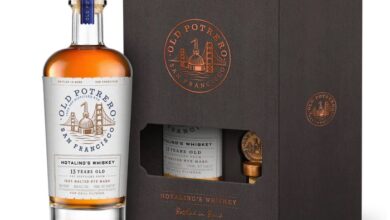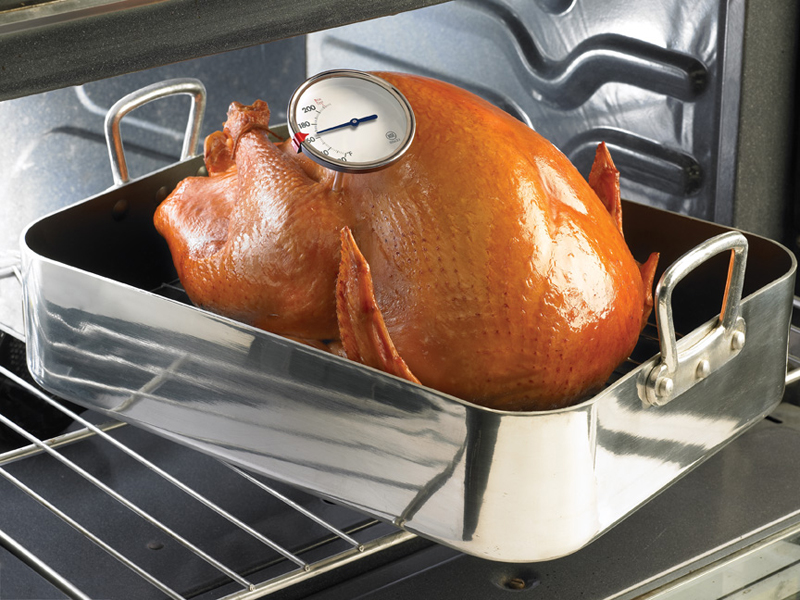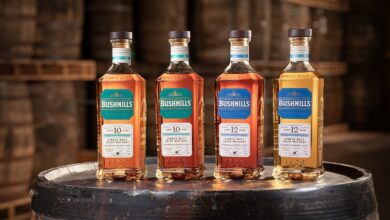Small Barrel Aging 101
By Richard Thomas
Renewed interest in small barrel aging has come up hand-in-hand with the micro-distilling boom, causing even big distilleries to get in on the act. Proponents of small barrel aging claim the use of smaller barrels allows them to create a superior product in a short space of time, an attractive proposition for a small start-up who would otherwise need to wait at least a few years before they could even begin to sell any product.
Yet critics claim small barrel aging accelerates only some of the benefits of oak barrel maturation, so the whiskey produced is left somewhat lacking. Even many whiskey-lovers do not really understand what happens inside an oak barrel over the months and years of primary and secondary maturation (or “finishing,” as the latter is often called), and therefore wonder what the advantages and disadvantages of using a 53-gallon barrel vs a 5- or 10-gallon barrel really are.
It’s All About Surface Area
Aging in a smaller barrel increases the proportion of interior barrel surface area to stored volume, putting more wood surface into contact with the whiskey within. It is a proven and demonstrable fact that this increased contact accelerates the rate at which the whiskey absorbs characteristics from the wood, such as color and an aged whiskey’s oaky and vanilla notes.
According to the American Distilling Institute, using a small barrel can turn out “an excellent product in only three to six months.” With such a quick turnaround time, it’s obvious why a new distillery might start with small barrel products, since it allows them to put something on the market in as little as half a year. The speedy maturation of small barrel aging is also a big plus for experiments, since it allows a distiller who is trying something new to see what the results might be much sooner.
What is true for micro-distillers and modern whiskey pioneers is doubly true of home distillers, for whom small barrel aging is usually the only practical choice. Few home distillers produce in the sheer quantity necessary to merit even one or two 53-gallon barrels, or have the patience necessary to wait many years to have a drinkable homemade whiskey.
The Downside
The key problem with small barrel aging is that it accelerates the absorption of everything else from the wood as well. A common misconception is that the longer a whiskey stays in the barrel, the better it gets. Nothing could be further from the truth.
Aging in oak is a delicate three-way dance between the climate, the whiskey and the wood. While the exact line is hard to determine with any specificity, aging a whiskey for too long imparts a nauseating astringency, especially if the wood in question is new oak.
This effect places a time limit on how long whiskey can sit in a barrel without “going bad,” and that limit comes much sooner for small barrels than big barrels. One or two years seems to be the most a whiskey can profit from being in a small barrel, and therein lies the problem. Many whiskey qualities come from esterification, or the reactions between wood acids, alcohol, oxygen, and various other chemicals, and those reactions take time. If you bottle your whiskey after 15 months, very little of that has happened, so critics of small barrel aging aren’t wrong when they say the processing choice “leaves something out.”
The decades-long aging periods that are a fixture of scotch-making produce such fine results in part because scotch-makers rely almost entirely on used bourbon, sherry and port casks for their primary maturation. Some of the oak’s less desirable qualities have already been used up during the first round of aging.
All bets are off for a small barrel finishing, as is the case for Laphroaig Quarter Cask. Finishing a whiskey in a second set of barrels is always meant to be a short term thing by its very nature, rarely lasting more than a year. For secondary aging, it’s hard to see what drawbacks small barrel use might have, if any.
Open Minds
Small barrel aging might not produce “traditional” whiskey, but what is traditional whiskey anyway? Even the products of a big, well-established label like Jack Daniel’s have changed periodically in ways that some found objectionable. Many whiskeys made today are quite different from what was being made a century or more ago, even for the big old names in scotch, Canadian and Irish whiskey that have been in continuous operation all that time.
Furthermore, more goes into an enjoyable bottle of whiskey that the oak its aged in. The size and nature of the barrel is just one factor, and while I can’t deny that small barrel aging leads directly to a more circumspect maturation period, that doesn’t mean it’s bad. Some whiskeys clearly come out very well indeed after only several months in a small barrel, in much the same way that some come out very poorly after several years in a big barrel.
The important thing to keep in mind about small barrel aging is that what matters is what you want from your whiskey. The proliferation of small barrel whiskey is a good thing in my book, because it means an experimentation boom in whiskey-making, and it’s great that American whiskey laws and organizations are liberal enough to permit such things. No one is telling Ranger Creek they can’t make mesquite-tinged bourbon in small barrels in the same way the Scotch Whisky Association (SWA) told Compass Box they couldn’t make The Spice Tree with French Oak staves. Think about that the next time a whiskey-snob scoffs at small barrel aging on the basis of “tradition.”





I would liken this to bottle-aging for wine. Bottle aging only matters for tanniny big reds, so no whites and some reds do not benefit from bottle aging at all. Some of these wines are great with no aging at all, and aging is sometimes harmful.
Some reds that benefit from bottle-aging are good right from the get-go, but as a rule they don’t hit their very best for five to eight years. After eight years, the chance that the wine will start deteriorating becomes greater and greater. Some big reds are sublime after 30 years in the bottle, but many have turned to vinegar by then.
That is a great analogy – thanks for sharing it!
Chuck Cowdery has been on the warpath with this issue. He’s hacking and shilling for the big distillers who don’t like the competition. I’ve stopped reading his stuff, because it smacks of what you talk about right at the end. The guy would just love it if he could shut all those guys down or make their lives harder.
If you really knew Chuck Cowdery (and I do), he is anything but a shill. In fact, he has been such an honest critic, that a couple of the biggies won’t cooperate with him. The price of independence and honesty. Believe me, I know.
His book on Bourbon, and his Kindle book on “Small Barrels Produce Lousy Whiskey) are competent, complete, honest and informative. Perhaps you and the a few large distillers should revisit what I consider an unfair rejection of a good man, who happens to be one of the most informed experts on whisky and aging.
He is a treasure.
Having followed Cowdery for the last five years or so, I’ve noticed he is VERY inconsistent on the small barrels issue. The thing I noticed is that he either scorns the practice (“it’s lousy!”) or he ignores that it’s going on and lets it slide, depending on who is doing it. Whether the whiskey itself is any good seems immaterial.
Another thing is that he flip flops on the whole “it’s lousy!” thing. Depending on what side of the bed he got out of, small barrel whiskey is either the devil or just different according to him.
So taken as a whole, I don’t think his track record on the small barrel issue is much to speak of.
Regarding Paulson’s comment on wine ageing: Many whites are improved by time in the bottle. Some that come to mind are good quality white Burgundies, (especially Premier and Grand Crus, ditto Chablis); Virtually all Sauternes; German and Alsatian Rieslings from good years, especially late harvest wines; Quart de Charmes from the Loire Valley. The list goes on. The key thing to remember is that many reactions in ageing take a certain amount of time as stated in the article. What these changes are can vary immensely based on a staggering number of variables.
@ “Captain Jimbo” — Cowdery has a very obvious record for scorning anything to do with small distilleries and bottlers. According to him, all small barrel whiskey and all unaged whiskey sucks… unless, of course, the latter t is made by Jim Beam or Jack Daniel’s.
I think we can draw our own conclusions from that, thank you very much.
Silly boy, true just because you say so? Spare me. A record so “obvious” that it can’t be cited? You say so. Scorning “anything” that has to do with small distilleries? Ridiculous. But you say so, so it must be true. It doesn’t take a genius to note that posters who use extreme adjectives like “always” or “anything” are gilding the lily. But thanks because it makes my job so easy: all I have to do is cite one small distillery’s product that he doesn’t scorn, lol.
How ’bout Corner Creek Reserve formerly of Miami, Florida? A very small distillery launched in 1998 and who was praised by Cowdery well before they were sold. There are others.
You see the real problem is that federal regulation favors big, deep-pocketed, concentrated and well financed companies. The new distillers simply don’t have the financial ability to sell enough new make or minimally qualifying young spirits, while having to set aside hundreds of thousands of dollars worth of aging product for six or eight years – BEFORE they can sell a drop of it, and without knowing IF it will sell. They can’t afford that investment so what to do?
Try naming all the small, micro or craft distillers who are offering well aged 6 to 12 year bourbons today. Instead of real aged bourbon many of these hopeful dreamers feel obligated to propose “fast aging” schemes wherein they claim (as does ADI, their hero) any number of fantastical techniques like loud rock music, new micro-barrels, ultraviolet light, inserting “specially treated” wood staves, pulsating air pressure and/or forced temperature changes, underwater aging, aging on barges… you name it. One small distiller even claims to produce a 10-12 year old bourbon equivalent in just 6 days.
And the general media even dutifully report these silly claims. This is not to say that all small barrel aging doesn’t work, but it depends on the definition. There are a handful that produce a minimally palatable product, but certainly nothing that remotely compares to the truly aged products they claim to emulate. Small barrels are often combined with these crackpot, snake oil schemes – yet somehow Cowdery is damned for pointing out the facts.
Other posters criticize him – and apparently now me – for being inconsistent while this poster criticizes him for not being flexible. Shameful.
So the guy who has a paid gig for the for-profit Mint Julep Tours and attacks the non-profit trade association KDA’s tour program in an obvious conflict of interest is your model for transparency, integrity, business ethics, and other good stuff? Really? Good luck to you with that.
Capt. Jumbo
The fact that you think Distillers that don’t age in 53 gallon barrels for years on end are crackpots is the most arrogant thing I have heard. Age does not mean quality. It’s about the maturation of whiskey and oak not age. I agree some people do a bad job trying to shorten the process but to say it’s not as good is just wrong. It should be about the final product not about what kind barrels and how long it’s aged. The first Whisky that comes to mind is Defiant American Single Malt. Those guys don’t use barrels(not sure how they do it) and it’s one of the best American Whisky I have ever had.
I make a “Scotch” that long time scotch drinkers say it is a very short distance from Johnny Walker. Now im not going to reveal my entire process but I will say this, it takes me 30 days from start to finish to produce this very well liked drink. Thats from cooking the mash to bottling the whiskey, 30 days total. So it can be done. Theres just not enough people experimenting to perfect the technique.
I’m aging whiskey in glass with a host of various woods, charred, toasted, and charcoaled. I have created a secret recipe that makes one of the best aged whiskies I have ever tasted. I also do this with rum, gin and vodka. I have a smoked maple vodka I made that is really good. Barrels are not always needed. You can expect to wait about 6 months for proper aging with wood in glass however.
I have a 3 gallon cask . I would like to put a red wine in it. Any suggestions, -lease